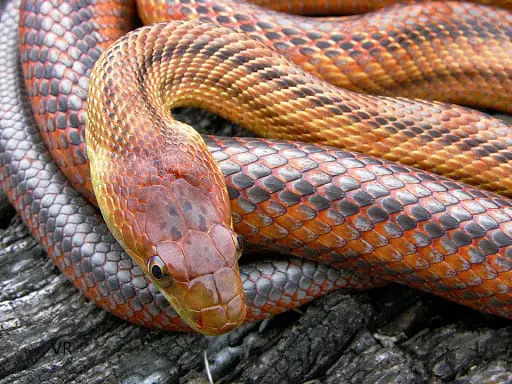
Description:
Scientific name: Pantherophis bairdi
Life span: 8-16 years
The harmless snake species Pantherophis bairdi belongs to the Colubridae family. Four stripes that extend from the neck to the tail are layered over an orange-yellow to brilliant yellow or a darker salmon foundation color to create the dorsal color pattern. Usually gray to yellow, the belly darkens towards the tail.
Native Region/Habitat
P. bairdi can be found in northern Mexico in the Mexican states of Coahuila, Nuevo León, and Tamaulipas as well as in the Big Bend region of western Texas in the United States. It’s reputed to be elusive and challenging to locate in the wild. Semi-arid, rocky environments are preferred by P. bairdi.

Behavior:
The Baird’s rat snake is a highly protective snake in the wild. They would rather flee and hide, but if threatened, they will defend themselves by biting. Their primary form of defense is to resemble a rattlesnake by making loud noises and vibrating their tail. Moreover, it has the capacity to emit a strong musk scent that can make people queasy. There aren’t many behavioral distinctions between females and males unless the female is laying her eggs
Despite these possible problems, it is safe to keep a Baird’s rat snake as a pet since, with enough time and regular care; it can grow tame and even like people. Wearing gloves and handling your snake with a hook is a good idea, though, until it has been acclimated to you.
Care As a pet/In captivity:
- For the wellness of your pet, it is essential to create a suitable environment for your snake.
- Your Baird’s is fairly adept at being kept in a 90cm vivarium as a fledgling as long as there are enough little pelts for it to feel secure. They are quite a lively snake; therefore as they grow older, they will be moved to a larger vivarium.
- Feed your rat snake a thawed rat or mouse once a week until it reaches maturity, at which point the feeding schedule can be reduced to once every two weeks. Prey items must not be wider than the snake at its thickest point and must be able to thaw out quickly in the refrigerator before being allowed to warm up.
- Rat snakes require a warm sleeping area all day long. A powerful spot tuber is placed at one end of the vivarium to achieve this. We use one 40w lying light in a 3 foot enclosure to practice the necessary lying temperature of 85oF-90oF. Rat snakes require a slight drop in temperature and general darkness in the evening. Turning off the laying light is necessary. Using a heated rug creates an 80°F temperature during the night. They produce heat but no light.
- Rat snakes must be fed once a week on thawed pinky mice as hatchlings. As the snake grows, the amount of food must be increased until it is eating large or even gigantic mice. Although they can get overweight if fed every week, mature rat snakes can be fed once every two weeks.
- On the chilly exterior of the enclosure, there ought to be a water bottle big enough for the snake to fit inside.
Table





